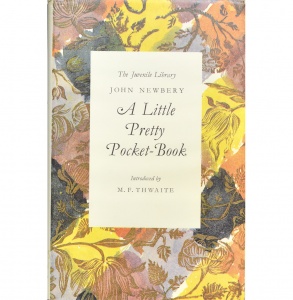A Pretty Little Pocket Book
Listen to the Recess! Clip
| Author | Rita Smith |
| Air Date | 6/19/2000 |

A Pretty Little Pocket Book Transcript
On June 18, 1744, the following advertisement appeared in the London Penny Morning Post: [Published] According to [an] Act of Parliament: a Little Pretty Pocket Book, intended for the instruction and amusement of little Master Tommy and pretty Miss Polly; with an agreeable letter to each from Jack the Giant Killer; a[nd] also a Ball and Pincushion, the use of which will infallibly make Tommy a good boy and Polly a good girl. To the whole is prefixed a letter on education, humbly addressed to all parents, guardians, governesses and wherin rules are laid down for makng their children strong, healthy, virtuous, wise, and happy. Printed for J. Newbery at the Bible and Crown, near Devereux Court,÷Price of the Book, 6d (pence); with a ball and pincushion, 8d (pence)(1)
This was John Newbery’s first advertisement for Little Pretty Pocket Book, his first publication for children, and it was a very important little book. According to children’s literature historian, J. F. Harvey Darton, the most “significant point of this book is that Newbery deliberately set out to provide amusement and was not afraid to say so.”(2) Up to this time, “[t]here were plenty of schoolbooks and guides to conduct, but none which would openly allow a child to enjoy himself with no thought of duty nor fear of wrong.”(3) Now, in the title, the word “instruction” does come before “amusement,” and there are some preliminary remarks meant for parents, but the rest of the book consists of pictures of children playing games, such as Hide and Seek, Thread the Needle, Cricket, and Leap Frog.(4) Each picture is headed with an upper or lower case letter of the alphabet and followed with a little rhyme, but the letter, the picture and the rhyme have very little to do with each other; they are just together on one page as a congregation of elements, any one of which might amuse a child. The books also includes a letter from Jack the Giant Killer explaining how to use the ball and pincushion and some fables.(5)
John Newbery didn’t have any particular theory of infant psychology and he didn’t promote this or that school of educational thought, although he did admire John Locke. He was simply an excellent businessman, who was the first to see that in his line of business, book publishing, children’s books deserved special attention and development, and he realized that there was a class of readers now ready to receive juvenile literature, fiction and nonfiction, for amusement as well as instruction. He prospered and his books proved by their success that they filled a need. Newbery has been called the “father of children’s literature,” and A Little Pretty Pocket Book was the beginning of something big. Although no one knew it at the time, it changed everything, and that is why Darton calls the year 1744, the 1066 of children’s literature.
(1) Towsend, John Rowe, John Newbery and his books: Trade and Plumb-cake for ever, Huzza!, p. 103-4.
(2) Darton, F.J. Harvey, Children’s Books in England, p. 2.
(3) Ibid., p. 1.
(4) Ibid., p. 2-3.
(5) Ibid., p. 4.
Sources: Darton, F. J. Harvey. Children’s Books In England: Five Centuries of Social Life. 3rd ed. New Castle, Delaware: Oak Knoll Press. 1982.
Townsend, John Rowe. John Newbery and his books: Trade and Plumb-cake for ever, Huzza! Metuchen, N. J.: Scarecrow Press. 1994.